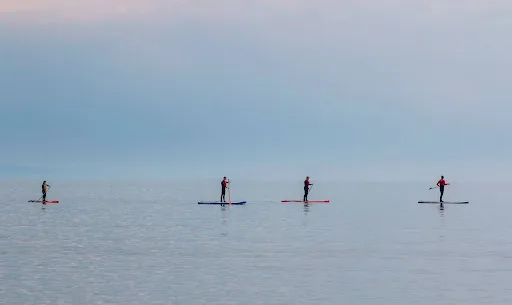Paddleboarding has surged in popularity over the years, becoming a beloved activity for water enthusiasts of all ages. Whether you’re gliding gracefully across calm lakes, catching waves at the beach, or exploring serene rivers, the right paddle board can significantly enhance your overall experience. However, with the plethora of options available on the market, selecting the perfect paddle board can be overwhelming.
This guide will provide you with essential insights into the various types of paddle boards, key features to consider, and tips for making an informed choice that suits your individual needs and lifestyle. Embarking on this adventure equipped with the right board will ensure you enjoy every moment on the water.
Types of Paddle Boards
When it comes to paddle boards, there are several types available, each designed for specific activities and water conditions. The two most common categories are all-around boards and touring boards. All-around boards are versatile and perfect for beginners, allowing users to navigate a variety of water bodies, from lakes to rivers and even some small waves. Their stability and wider design make them user-friendly, helping paddlers feel comfortable while they develop their skills. On the other hand, touring boards are longer and narrower, making them ideal for those looking to paddle longer distances and at higher speeds.
These boards are built for efficiency and glide, often featuring a streamlined shape that cuts through the water more easily than all-around models. With the increased quality of inflatable paddle boards, touring boards are now more accessible and convenient for transportation and storage. Other types of paddle boards include racing boards, designed for speed and agility in competitions, yoga boards with a wider surface area for stability during poses, and even fishing-specific paddle boards with added features such as fishing rod holders. Consider your intended use before choosing the type of paddle board that suits you best.
Key Features to Consider
When choosing a paddle board, several key features should influence your decision. One of the most important factors is the board’s size and weight capacity, as this will determine how well it accommodates your body type and intended use. A larger board offers better stability and is often preferred for recreational paddling, while smaller boards are generally faster and more agile, which is beneficial for more experienced users.
Additionally, consider the material of the paddle board. Inflatable boards offer portability and ease of storage, making them great for travel and casual use. However, hard boards typically provide better performance and durability for enthusiasts who plan to paddle frequently and tackle rougher waters. Understanding these features will help you select a board that aligns perfectly with your paddling goals.
Paddle Board Accessories
Investing in the right accessories can significantly enhance your paddle-boarding experience. A good paddle is essential, as it affects your efficiency and comfort on the water. Paddles come in various materials, including aluminum, fiberglass, and carbon fiber, with each type offering different weight and stiffness levels. Choosing the right paddle that matches your height and paddling style can greatly improve your control and speed.
Additionally, consider safety accessories such as personal flotation devices (PFDs) and leash systems. A PFD is vital for ensuring your safety while paddling, especially if you’re venturing into open waters or unpredictable conditions. A leash is equally important, keeping you connected to your board in case of a fall, and preventing you from losing your board to the current. These accessories not only enhance your safety but also contribute to a more enjoyable outing on the water.
Weather Conditions and Safety
Understanding weather conditions is crucial for a safe paddle-boarding experience. It’s essential to check local forecasts before heading out, as changes in wind and weather can significantly impact your time on the water. Strong winds can create challenging paddling conditions and increase the risk of capsizing, particularly for novice paddlers. Ideally, plan your outings on calm days, which offer the best environment for enjoyable paddling.
Additionally, always adhere to safety protocols while on the water. Inform someone about your paddling plans, including your expected return time. Carry a waterproof phone or GPS device for emergencies, and consider bringing a whistle or signal mirror for added safety in case you require assistance. Being prepared can prevent unforeseen issues and allow you to fully enjoy your paddle-boarding adventure.
Choosing the perfect paddle board involves careful consideration of your individual preferences, intended use, and the various features available. Whether you opt for an all-around board for versatility, a touring board for longer excursions, or even a specialized board for yoga or fishing, the right choice will ultimately enhance your enjoyment on the water. Don’t forget to invest in essential accessories and stay informed about weather conditions to ensure a safe and pleasurable experience. As you embark on your paddle-boarding journey, remember that the key is to have fun and make the most of your time surrounded by nature.






